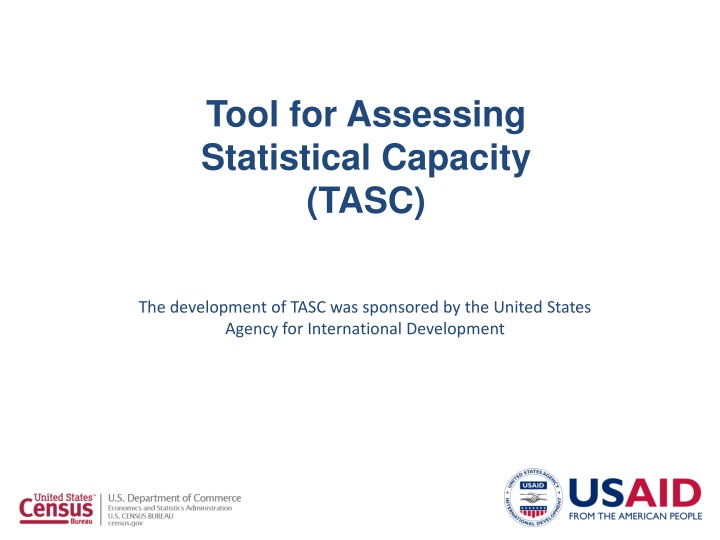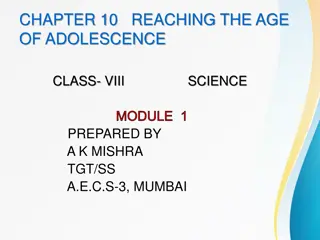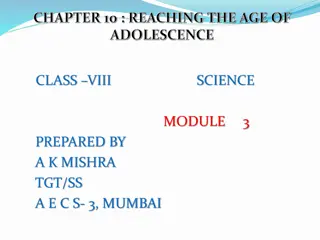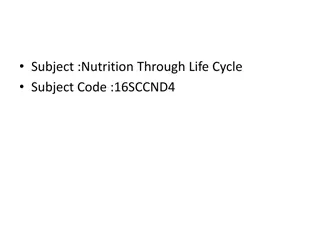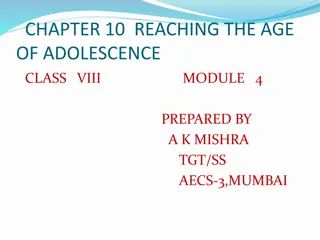Adolescence: Family Dynamics and Transformative Phenomena
Adolescence is a crucial phase marked by significant changes in brain development, behavior, and social interactions. This period involves a joint evolutionary effort between adolescents and their families, navigating issues such as identity formation, autonomy, and relationship dynamics. Explore the transformative processes in adolescence, including biological, hormonal, and psychological changes, as well as cognitive development and emotional regulation. Understand the challenges and opportunities presented by adolescence in the context of family relationships and individual growth.
Download Presentation

Please find below an Image/Link to download the presentation.
The content on the website is provided AS IS for your information and personal use only. It may not be sold, licensed, or shared on other websites without obtaining consent from the author.If you encounter any issues during the download, it is possible that the publisher has removed the file from their server.
You are allowed to download the files provided on this website for personal or commercial use, subject to the condition that they are used lawfully. All files are the property of their respective owners.
The content on the website is provided AS IS for your information and personal use only. It may not be sold, licensed, or shared on other websites without obtaining consent from the author.
E N D
Presentation Transcript
Tool for Assessing Statistical Capacity (TASC) The development of TASC was sponsored by the United States Agency for International Development
Outline About the TASC Format A Look at the TASC Filling out the TASC Modules 2
About the TASC The Tool for Assessing Statistical Capacity (TASC) was developed by the U.S. Census Bureau with the support of the U.S. Agency for International Development (USAID). 3
About the TASC Identifying areas of strength and weakness in the preparedness of an National Statistical Office (NSO) to conduct a census or survey is difficult and subjective. The TASC addresses this by providing quantitative measures of the capacity of an NSO to conduct a census or survey. 4
What is statistical capacity? Statistical capacity is a nation s ability to collect, analyze, and disseminate high-quality data about its population and economy -as defined by The World Bank http://datatopics.worldbank.org/statisticalcapacity/ 5
About the TASC Results from the TASC can be used by NSOs and their stakeholders to: Provide a measurable score for statistical capacity, and Identify specific areas where the NSO could benefit from further training. The TASC can be conducted at two different points in time to assess improvement or impact of an assistance program. 6
Format Operational Modules The TASC has an operational module for each step of a census or survey: Planning and Management Mapping Sampling Questionnaire Content and Testing Field Operations Data Processing Data Analysis and Evaluation Data Dissemination Publicity 7
Format Institutional Capacity In addition to these operational modules, there is an additional module that measures the overall institutional capacity of an NSO. The TASC was organized in this way to: Facilitate administration Clearly define the areas where the NSO rates high or low on statistical capacity 8
Format Each of the operational modules is divided into four subsections: Human and physical capital Methodological soundness and international standards Quality assurance Written procedures and documentation 9
Format A mobile data capture score is provided. The mobile data capture score combines questions related to mobile data capture onto one sheet. The mobile data capture score: Is not based on a separate mobile data capture section Reflects the cross-disciplinary skills necessary to implement a mobile data capture census or survey 10
A Look at the TASC Questions can be rated from 0 to 3, with: 3 = highest score 0 = lowest score N/A = if the question does not apply to you 13
Filling out the TASC You will receive an answer sheet. Please: Read each statement carefully Choose the most appropriate answer Write that answer on the answer sheet 14
Filling out the TASC The TASC is filled out in two stages: Individually As a group 15
Filling out the TASC Remember that accurate answers will help: Give your organization recognition where it is deserved Identify areas for further training and technical assistance 16
Modules As a reminder, the 10 modules of the TASC are: 1. Institutional Capacity 2. Planning and Managing 3. Mapping 4. Sampling 5. Questionnaire Content and Testing 6. Field Operations 7. Data Processing 8. Data Analysis and Evaluation 9. Data Dissemination 10. Publicity 17
Modules The next few slides describe what aspects are measured in each module. Please make a note of the specific modules that relate to your work experience and skills in this organization. 18
Modules The Institutional Capacity module asks questions concerning: The legal background for censuses and surveys Data confidentiality practices Organizational structure of the NSO Human and physical capital of the NSO Stakeholder coordination 19
Modules The Institutional Capacity module should be completed by: Census and Survey Managers Managers of other areas involved in censuses and surveys (e.g. IT, field operations) 20
Modules The Planning and Management module asks questions concerning: Planning and management of staff, budget, and other resources Other aspects of planning and management such as number of people trained or software used Should be taken by: managers 21
Modules The Mapping module asks questions concerning: Skill level and software used by mapping personnel Characteristics of the maps Scope of the mapping program Dissemination using maps Should be taken by: mappers / cartographers 22
Modules The Sampling module asks questions concerning: Methods for sampling, data adjustments, calculating sampling error, etc. Sampling frames Should be taken by: statisticians 23
Modules The Questionnaire Content and Testing module asks questions concerning: How questionnaire content is chosen and tested Balancing international standards with historical continuity and local context Should be taken by: subject matter specialists and demographers 24
Modules The Field Operations module asks questions concerning: Plan for hiring and training enumerators Tracking forms in the field Pilot testing Enumerator manuals Should be taken by: staff involved in field activities 25
Modules The Data Processing module asks questions concerning: Software used for data processing Edit and imputation specifications Operational control during data processing Tabulation plan Should be taken by: IT staff, programmers, and subject matter staff 26
Modules The Data Analysis and Evaluation module asks questions concerning: The skills of staff involved and software used The demographic analysis program Post Enumeration Survey Population projections Should be taken by: statisticians and demographers 27
Modules The Data Dissemination module asks questions concerning: Skills of the staff Variety of dissemination formats Confidentiality standards Publication standards Should be taken by: subject matter, web design, and dissemination staff 28
Modules The Publicity module asks questions concerning: Integrating communication efforts Interaction with the public Partner outreach Should be taken by: management, publicity, and dissemination staff 29
Your Experience and TASC Briefly mention your experience with censuses and surveys. Which modules do you think you should take? 30
I hope you enjoy answering the TASC. Thank you for Participating! 31
Intentionally left blank Next slide to be shown once the TASC has been administered 32
Feedback What did you like about the TASC? How can it be improved? Did it accurately measure the major activities you perform in your job? If not, what was missed? Any other feedback? 33
Slide Instructions Administrative Records If an NSO uses administrative records, change the presentation by doing the following- Replace slides 8 and 17 with the next 2 slides. Add the final slide after slide 29 (Module discussing Publicity)
Format In addition to these operational modules, there are two other modules Institutional Capacity measures overall capacity of the NSO Administrative Records measures the ability of the NSO to use and link data from various administrative records and registers The TASC was organized in this way to: Facilitate administration Clearly define the areas where the NSO rates high or low on statistical capacity
Modules As a reminder, the 11 modules of the TASC are: 1. 2. 3. 4. 5. 6. 7. 8. 9. 10. Publicity A. Administrative Institutional Capacity Planning and Managing Mapping Sampling Questionnaire Content and Testing Field Operations Data Processing Data Analysis and Evaluation Data Dissemination 37
Administrative Records Module The Administrative Records module asks questions concerning: The legal basis for the use of administrative records The skills of staff to link records The harmonization of concepts and definitions between the various registers Availability and use of metadata in linkages Should be taken by: statisticians and programmers
